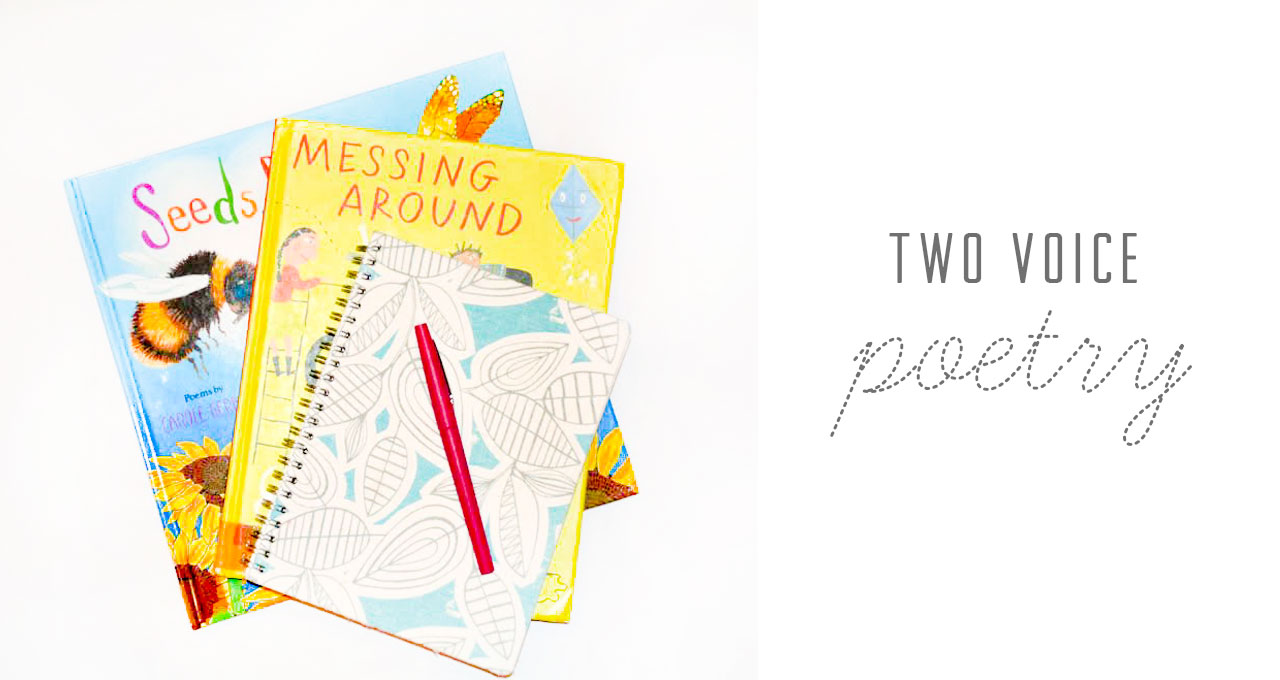Two Voice Poetry

I’ve always felt that poetry is communal. First of all, it’s accessible to everyone regardless of age, poetic experience, or writing ability. My six year old can write as profound a poem as anyone. Secondly, poetry is a genre meant to be shared and enjoyed with others. Poetry creates a sense of community and has the power to evoke emotions and build relationships in a way that ordinary prose simply cannot.
A poem in two voices offers a unique way to showcase two distinct perspectives or to compare and contrast two items, and it lends itself to being read out loud and performed for others. This type of poetry is usually written in two columns so that one person speaks at a time. The two voices go back and forth so that it becomes a dialogue or conversation between the two voices. If the poet wants the voices to come together as one, the words are either written in the center of the page or on the same line in each of the two columns.
Last week I introduced this form of poetry to my second and third graders and handed each pair of students a book with a collection of two-voice poems. I expected a few moans and groans (which I always seem to get when I ask students to pair up and read something together). I wasn’t expecting what came next.
For over half an hour, my students devoured these poems. They took turns reading different parts, they laughed, they questioned, and they passed the books back and forth (all while building their vocabulary, comprehension and fluency). Of course, we then spent another 30 minutes sharing our favorite poems with one another and performing them in front of the group. Not a bad way to spend the morning.
Our next step will be to write our own two-voice poems. Want to try it with us? Here are some easy steps to get you started.
- Choose two items, objects or people that have a relationship.
For example:
– Book characters (Charlotte & Wilbur)
– Family members (brother & sister)
– Animals (cat & dog)
– Seasons (winter & spring)
– Flowers (tulip & daffodil)
– Friends (you & your bestie)
You get the idea, and if you think creatively the possibilities are literally endless. Use the book list below for even more inspiration!
- Brainstorm some words, ideas or phrases for each of the items. Think about how the items are similar and different from one another. It might be helpful to use a graphic organizer (two-column chart or Venn diagram) to get your ideas in order, but it’s not necessary!
- Begin writing your poem, in two separate columns, so that each item has a distinct voice. Consider whether or not your two voices will speak together at certain points in your poem. If so, try writing those lines in the center of the page.
- Practice reading your poem. When you feel ready, perform your poem in front of others! If you haven’t written your poem with a partner, find a friend who will read the poem with you. Don’t forget to switch parts every once in a while. It’s always fun to hear the lines being read in a different voice.
There are also many other concepts that can be taught during this activity:
- Personification
- Determining point of view
- Comparing and contrasting themes, settings, plots, and characters
- Reading with fluency to support comprehension
- Using graphic organizers
Here are a few books to enjoy and be inspired by:
- Joyful Noise: Poems for Two Voices by Paul Fleischman
- Messing Around on the Monkey Bars and other School Poems for Two Voices by Betsy Franco
- Seeds, Bees, Butterflies and More! Poems for Two Voices by Carole Gerber
- You Read to Me, I’ll Read to You* by Mary Ann Hoberman
*There are six different books in this series including the original Very Short Stories, Tall Tales, Fairy Tales, Fables, Mother Goose Rhymes, and Scary Stories.
Two-voice poems could also be used as a response to another text or written to support an opinion about a topic or text. I’ve frequently used them at the beginning of the school year when we are first getting to know one another; it’s a perfect medium to begin building community and establishing relationships in the classroom.
